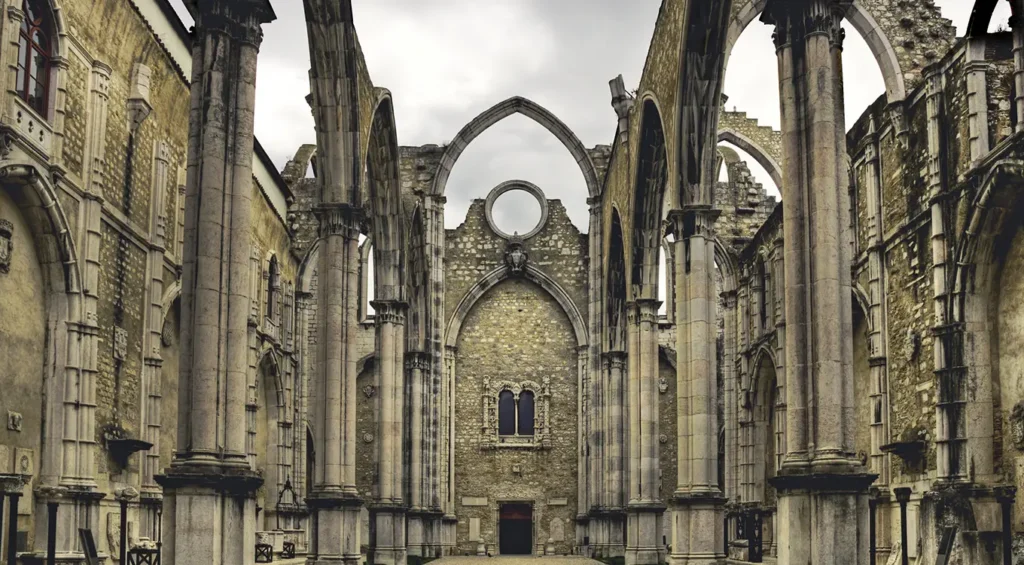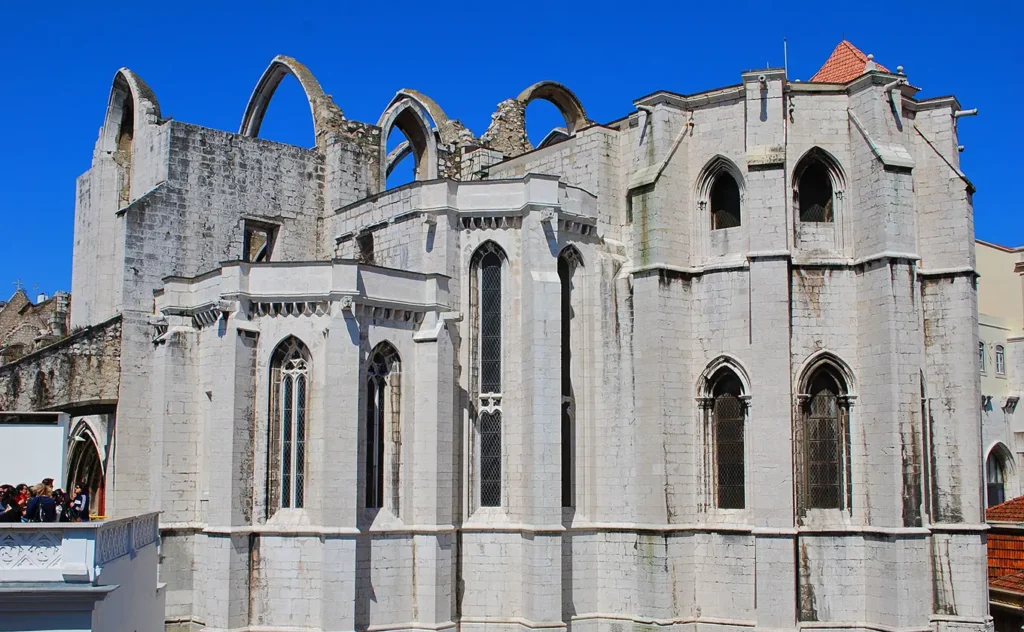Igreja do Carmo is a must-see historical landmark in Lisbon, Portugal. This captivating architectural masterpiece, with its roofless nave open to the sky, tells a story of resilience, destruction, and the passage of time.
Official Website
While a dedicated website solely for Igreja do Carmo was not found, information about the church is available on the website for Igreja do Convento do Carmo, which encompasses the convent, church, archaeological museum, GNR Museum, and terraces. It’s worth noting that Igreja do Carmo and the convent are part of “Lisboa Pombalina”, classified as a Public Interest Site, adding to their historical significance.
A Glimpse into History
Construction of the Carmo Convent began in 1389, funded by Nuno Álvares Pereira, a national hero who played a crucial role in securing Portugal’s independence from Castile. Pereira vowed to build the world’s most beautiful church if he was victorious in the Battle of Aljubarrota in 1385, and true to his word, he financed the construction of this magnificent Carmelite church and convent. The church, with its grandeur and monumentality, rivalled Lisbon’s Sé Cathedral and the Convent of S. Francisco.
The Carmo Convent housed a library with over 5,000 volumes, a testament to the intellectual and cultural life within its walls. Tragically, this collection was lost in the devastating earthquake of 1755. On November 1st of that year, an earthquake, estimated at 9 on the Richter scale, struck Lisbon. The earthquake caused the church’s roof to collapse, killing hundreds of worshippers gathered for All Saints’ Day. The fires that ensued raged for days, further contributing to the destruction.
It’s important to note that the Carmo Convent is one of the few remaining ruins from the 1755 earthquake, offering a poignant glimpse into the scale of destruction the city faced. This makes it a significant historical site for understanding the impact of the disaster on Lisbon and its subsequent rebuilding.
Although reconstruction efforts began three years later in a Neo-Gothic style, they were halted in 1834 due to the abolition of religious orders in Portugal. The pillars and arches of the naves date from this reconstruction period and are genuine examples of experimental Neo-Gothic architecture.
The Carmo Convent also played a significant role in the Carnation Revolution of 1974, which marked the end of Portugal’s dictatorship. It was within the convent walls that Marcello Caetano, the last president of the Estado Novo regime, sought refuge from the military revolutionaries.
Architectural Significance
The Igreja do Carmo is an exemplary illustration of Gothic architecture in Portugal. Its design, characterized by high naves and ribbed vaults, evokes a sense of majesty and spiritual elevation. However, what truly sets Igreja do Carmo apart is its roofless state? The absence of a roof, a consequence of the 1755 earthquake, transforms the church into a unique architectural experience. Visitors can stand within the skeletal structure and gaze up at the open sky, offering an unusual perspective on Gothic architecture and the interplay of light and shadow.

The church’s construction was not without its challenges. Unstable ground conditions led to structural issues and cracks, causing the southern side of the church to collapse in 1399. To address this, five semicircular buttresses were added to reinforce the building, a feature still visible today.
The church’s eastern facade, opposite the main entrance, was considered its most elegant feature. Constructed entirely from stone and marble, with occasional wooden elements, it showcased the craftsmanship of the era. The main facade features a portal with several archivolts and capitals adorned with vegetal and anthropomorphic motifs. Above the portal, a partially destroyed rose window hints at its former glory.

While the Gothic style dominates, the convent also exhibits elements of Manueline architecture, a uniquely Portuguese style known for its ornate decorations, maritime motifs, and grandeur. The iconic rose window, a hallmark of Manueline design, is a sight to behold, with its intricate stonework and floral patterns.
Cultural Significance
Igreja do Carmo stands as a poignant symbol of Lisbon’s resilience. Its roofless structure serves as a constant reminder of the devastating earthquake of 1755, while also showcasing the city’s ability to preserve its history and adapt to adversity. The stark contrast between the church’s ruined state and its enduring historical and cultural significance creates a powerful and moving experience for visitors.
Today, the Igreja do Carmo is not merely a historical site but also a cultural venue. It houses the Museu Arqueológico do Carmo (Carmo Archaeological Museum), which features a diverse collection of historical artefacts. The museum’s collection includes items from various periods and regions, including pieces from the Roman, Visigoth, and Moorish periods, as well as an Egyptian mummy and South American mummies. Other notable artefacts include the “Sarcophagus of the Muses”, the Baroque tomb of Queen Maria Anna of Austria, and the Gothic tomb of King Ferdinand I.
Visiting Igreja do Carmo
This section provides practical information for those planning to visit Igreja do Carmo and its associated museum:
Opening Hours
The Carmo Archaeological Museum is open from Monday to Saturday. The opening hours vary depending on the season:
- November to April: 10 a.m. — 6 p.m. (Last entry at 5:40 p.m.)
- May to October: 10 a.m. — 7 p.m. (Last entry at 6:40 p.m.)
- Easter week and December 26th to January 6th: 10 a.m. — 7 p.m. (Last entry at 6:40 p.m.)
The museum is closed on Sundays, January 1st, May 1st, and December 25th.
Ticket Prices
| Ticket Type | Price (€) |
|---|---|
| General Admission (15-64 years) | 5.00 |
| Student | 4.00 |
| Senior (65+) | 4.00 |
| Lisboa Card | 4.00 |
| Groups (30+) | 4.00 |
| Reduced Mobility | 4.00 |
| Guided Tour | 7.00 |
| Senior Guided Tour | 7.00 |
| Student Guided Tour | 7.00 |
| Children (up to 14 years) | Free |
Rules and Guidelines
For the preservation of the artefacts and the safety of visitors, certain rules are in place within the museum. Notably, touching the displays is prohibited.
Payment Methods
The museum accepts various payment methods for convenience, including cash (euros only), debit cards, credit cards, and MB Way.
Accessibility
Information regarding accessibility for people with reduced mobility is limited. However, the ticket prices indicate a discounted rate for individuals with reduced mobility, suggesting that the museum might offer some accessibility features. For detailed information, it is advisable to contact the museum directly.
Getting There
Igreja do Carmo is located in the Chiado neighbourhood, easily accessible by various modes of transportation:
- Metro: Baixa-Chiado Station
- Bus: Route 758
- Tram: Tram 28
- Elevator: Elevador de Santa Justa (connects Baixa district to Largo do Carmo)
If you are driving, parking is limited in the area, so visiting on foot or by taxi is recommended.
Brochures
To enhance your visit, the Carmo Archaeological Museum offers brochures in various languages, including Portuguese, English, Spanish, French, Italian, and German. These brochures likely provide detailed information about the museum’s collection and the history of Igreja do Carmo.
Nearby Attractions
Largo do Carmo, the square where Igreja do Carmo is located, is a charming plaza with a relaxed atmosphere. It offers a peaceful escape from the bustling city and is home to several notable attractions:
- Elevador de Santa Justa: This magnificent industrial-age elevator, built in 1902, connects Largo do Carmo to the Baixa district. Its Gothic-inspired arches and wooden cabins offer a unique experience. At the top, a viewing platform provides panoramic views over central Baixa. You can access the elevator via the nearby Baixa-Chiado metro station.
- Chafariz do Carmo: This ornate fountain, located at the center of Largo do Carmo, once provided fresh water for the entire district.
- Igreja de São Roque and Igreja de Santa Catarina: These two beautiful churches are located near Igreja do Carmo and are worth a visit.
- Rossio: This lively square, a short distance from Igreja do Carmo, is a popular meeting point and home to numerous shops, restaurants, and historical buildings.
Reviews from Expats and Tourists
While specific reviews from expats and tourists were not found in the available information, general opinions suggest that Igreja do Carmo is a fascinating attraction. Visitors appreciate its unique atmosphere and the opportunity to explore the ruins of a once-majestic church. The small archaeological museum within the church is also praised for its eclectic collection of artifacts.
Conclusion
Igreja do Carmo is a captivating historical landmark that offers a unique glimpse into Lisbon’s past. Its roofless structure, a testament to the devastating earthquake of 1755, stands as a symbol of resilience and remembrance. The church’s architectural beauty, combined with the fascinating artefacts housed in the Carmo Archaeological Museum, makes it a must-visit destination for expats and tourists alike.
History buffs will be enthralled by the layers of history embedded within the church’s walls, from its medieval origins to its role in the Carnation Revolution. Photography enthusiasts will find endless inspiration in the interplay of light and shadow within the roofless nave and the intricate details of the surviving architecture. Those seeking a peaceful retreat within the city can find solace in the tranquil atmosphere of Largo do Carmo and the contemplative space of the ruined church.
Whether you are interested in history, architecture, or simply soaking in the atmosphere of a bygone era, Igreja do Carmo is sure to leave a lasting impression.




